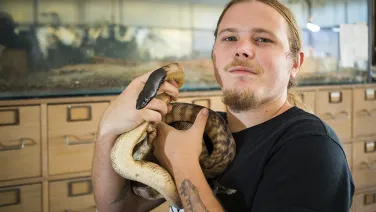Spags, snags and the secret of blind snake evolution
This student blog is written by Sasanan (Sand) Trakansuebkul, PhD student from the Fischer Group and winner of the 2024 ANU 3-Minute Thesis Competition.
Blind snakes are some of Australia’s most elusive, mysterious creatures.
But one dedicated postdoc from ANU has shed more light on these peculiar little snakes by unravelling their genetic secrets. Little did he know that a pasta pun would wiggle its way into the heart of their evolutionary story.
“Like all living beings, blind snakes play a vital role in the ecosystem,” says Dr Putter Tiatragul from the ANU Research School of Biology.
“What’s really fascinating is that they’re a unique group of snakes that actually eat insects.”
But these non-venomous snakes almost look and act more like worms.
“They are adapted to living underground and eating pupae and larvae of ants and termites,” explains Dr Tiatragul.
Blind snakes are tricky to study and to classify for a number of reasons. They are slippery, small, and surprisingly difficult to catch as they spend so much time hiding underground.
There are also many different species that are tricky to tell apart, with little variation in colour, pattern, or head shape, and the differences in their teeny tiny scales are tedious to count. A scientist’s worst ‘Where’s Wally’ puzzle.
Blind snakes are a unique lineage, separate from the so-called ‘advanced modern snakes’, like cobras and pythons, which are much easier to identify given their obvious features.

Not deterred by the unconventional traits of blind snakes, Dr Tiatragul took up the challenge to unravel the evolutionary history of Australia’s blind snake species.
To study these elusive animals, Dr Tiatragul took advantage of invaluable blind snake specimens that others have collected over hundreds of years in museum collections across Australia – proof that sometimes, the best place to dig up dirt on a species is behind glass, not the ground.
Immediately when he began this work, Dr Tiatragul noticed two distinct groups. He saw that some blind snakes are long and slender like spaghetti, while others are thick like sausages. So, Dr Tiatragul playfully dubbed them: spags and snags. Just as spaghetti and sausage recipes come in different shapes and sizes, so do these snakes, each adapted to their environment.
Dr Tiatragul genetically sampled specimens from a range of locations to determine how many lineages exist and to check if the species identified by appearance match their genetic story. He used this genetic data to create a phylogenetic tree – a family tree for species – to better understand how different blind snakes are related to each other.
The phylogenetic tree uncovered hidden groups that look identical, but are genetically distinct. While 47 species of blind snakes are currently recognised, there are likely many more lurking beneath the surface just waiting for their formal debut.

That got Dr Tiatragul thinking: Why are there so many blind snake species when they all look so similar?
It turns out that, albeit small, differences do exist – especially when you consider the soils they live in. Australia’s underground world isn’t uniform; soil properties range from dry, compacted beach-like sand to wet sand, to rocky ground, to softer, organic-rich soils.
And the snakes seem to match.
Dr Tiatragul mapped the blind snake’s morphology to their habitats, and discovered distinct patterns: spags, which are slender for their size, inhabit harder, compacted soils, suggesting they rely on pre-existing tunnels and burrows. These habitats tend to be drier, which likely contributes to the more compacted soils.
In contrast, snags, which are stockier for their size, are generally found in less compacted soils in more humid environments. This finding suggests that in softer soil where snakes can dig their own burrow, having a stronger build is advantageous.
Dr Tiatragul took this knowledge back to his office and started investigating photographs of the blind snake specimens. He documented head shapes of the blind snakes and, using X-ray images, meticulously counted the number of vertebrae in each of the snakes' spines, which ranged from 150 to almost 400.
Hundreds of X-ray scans later, he’d counted a total of 79,444 vertebrae. Yes, he kept count – and he’s proud of it (despite the repetitive strain injury it caused).
Eventually, all the numbers painted a further picture of what was going on.

The stocky snags had fewer vertebrae than the long, slender spags. Fewer vertebrae could mean they’re less flexible, while the spags might have more flexibility thanks to their extra vertebrae.
Noticing those distinct categories of spags and snags turned out to be the key to a surprisingly complex evolutionary story.
Despite both physical and genetic differences, blind snake evolution doesn’t follow the classic pattern of adaptive radiation. Instead, they are an example of non-adaptive radiation, where lineages diversified without corresponding variation in morphological or ecological traits.
This type of evolution is common on small islands, but for a big land-mass like Australia, it’s another example of blind snakes going against the grain.
So, next time you sit down with your favourite comfort spaghetti or sausages, remember there's a different type of spags and snags hidden right under your feet.



